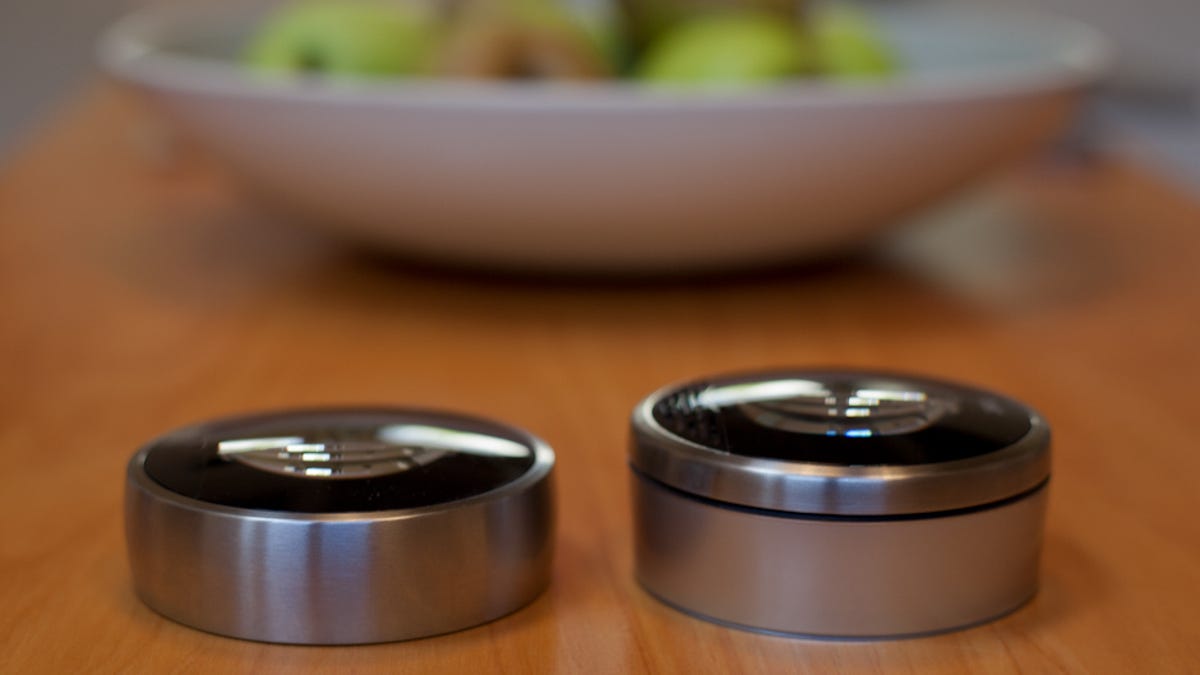Nest 2.0: Slimmer, sleeker thermostat smarter than ever
The latest thermostat from the "Father of the iPod" is 20 percent thinner and works with nearly all home heating or cooling systems. New software also is smarter than previous version.

When the "Father of the iPod" Tony Fadell unveiled Nest, the "learning thermostat" last fall, it was likely the first time anyone had ever thought of a thermostat as sexy.
Now, less than a year after the first version of the product arrived, bringing Apple style design and user interfaces to what had traditionally been one of the most staid home appliances, Fadell's Palo Alto, Calif.-based company today announced Nest 2.0, a slimmer version of the thermostat that was built to work in more homes and brings new flexibility and features to the table. It will cost $249 and be available in mid-October.
The new Nest takes the same electronics from version 1.0 and fits them inside a sleek, stainless steel body that is 20 percent thinner than its predecessor. Plus, by expanding from eight interior connectors to ten, Nest is now said to be compatible with 95 percent of the American and Canadian low voltage residential heating and cooling market, up from 75 percent for the first version (see CNET's review of Nest 2.0).
"What we are trying to do is reach out to even more demanding customers," explained Maxime Veron, Nest Labs' head of product, "enabling them to control more advanced and high-end systems than before."
For example, Veron said, many air conditioners have only an on/off switch. But more advanced models can have two stages -- one at around 50 percent capacity and another at 100 percent. Verson said that the second stage is controlled by its own wire, and that Nest 2.0, by expanding from the eight connectors in the first version to ten in the second, now supports that second air conditioning stage. And that'll be good news for a lot of high-end A/C owners, he explained, because Nest 1.0 wasn't compatible with many of them.
The second-generation Nest also brings similar new compatibility to homes with three-stage heating systems, and those with emergency heat for heat pumps, and whole-home humidifiers and de-humidifiers.
Over the last year, Nest 1.0 became a best-seller on Amazon, at Lowe's, and on Apple's online store. And that's likely because the thermostat's ability to learn and adapt to people's lifestyles has saved the average user almost 20 percent of their annual energy bill.
New software
Timed to go along with the unveiling of the second generation learning thermostat, Nest today also announced the 3.0 version of its software, an update that will be available to every Nest owner, and that the company said should make the appliance more efficient and adaptable than ever.
The software has always had an auto-away feature, but now it has been redesigned to detect more conclusively that no one is home. That means, Veron explained, that while the previous version of the software needed to wait two hours after everyone left to turn off heating or cooling, the latest version will be able to do so within 30 minutes of departure "based on a statistical analysis of your home and your patterns."
At the same time, Nest 3.0 software has an improved auto-scheduling program that can work with homes with both heating and cooling. The previous version worked only with one or the other.
And finally, the new software features a set of tools known as System Match. These are designed to help the thermostat adapt to users' homes, even when they have unconventional heating or cooling setups. Mainly, these seem to be aimed at letting users wake up with their homes at their desired temperature, regardless of whether they have a forced-air, radiant heat, or heat pump system. It is meant, Veron said, to learn how long a home takes to heat up or cool down and to match that information with an understanding of occupants' wake-up time.
Veron said that what sets the new version of the Nest software apart from any other system is that it is smart enough to learn precisely how long it takes to get a home to the desired interior temperature, taking into consideration current weather conditions.
More mobile support
Befitting a product made by a team full of ex-Apple employees, Nest 1.0 was compatible with both the iPhone and iPad, as well as Android smart phones. But now, the company is adding support for Android tablets, including the Nexus 7 and the Kindle Fire. That should expand the percentage of Nest owners that control their thermostat remotely using their mobile devices, which was already at more than 90 percent.
And, users can now set their Nest and their Nest apps up to use French or Spanish, in addition to English.
Honeywell lawsuit
Earlier this year, leading thermostat maker Honeywell sued Nest, claiming that the startup had infringed on seven of its patents.
But Veron said the U.S. Patent Office has already dismissed five of those claims and added that Nest Labs last week requested a stay for the remaining two. "We still stand by [our claim] that we didn't infringe," Veron said.

